Medication Order Validation and Administration in Nursing Practice
VerifiedAdded on 2022/09/26
|7
|1519
|35
Report
AI Summary
This report delves into the critical aspects of medication management in nursing practice. It begins with a thorough examination of validating a medical order, ensuring accuracy and patient safety. The report then explores the therapeutic interactions of prescribed medications, specifically focusing on the implications of administering Benzylpenicillin and Warfarin, considering potential risks and contraindications. Furthermore, it details the proper procedure for administering intravenous (IV) push medications, emphasizing the importance of safety checks and monitoring. The report also highlights the essential elements of medication documentation, stressing the need for accurate, timely, and comprehensive record-keeping to prevent errors and ensure optimal patient care. The content is supported by peer-reviewed sources and provides guidelines for best practices in medication administration.
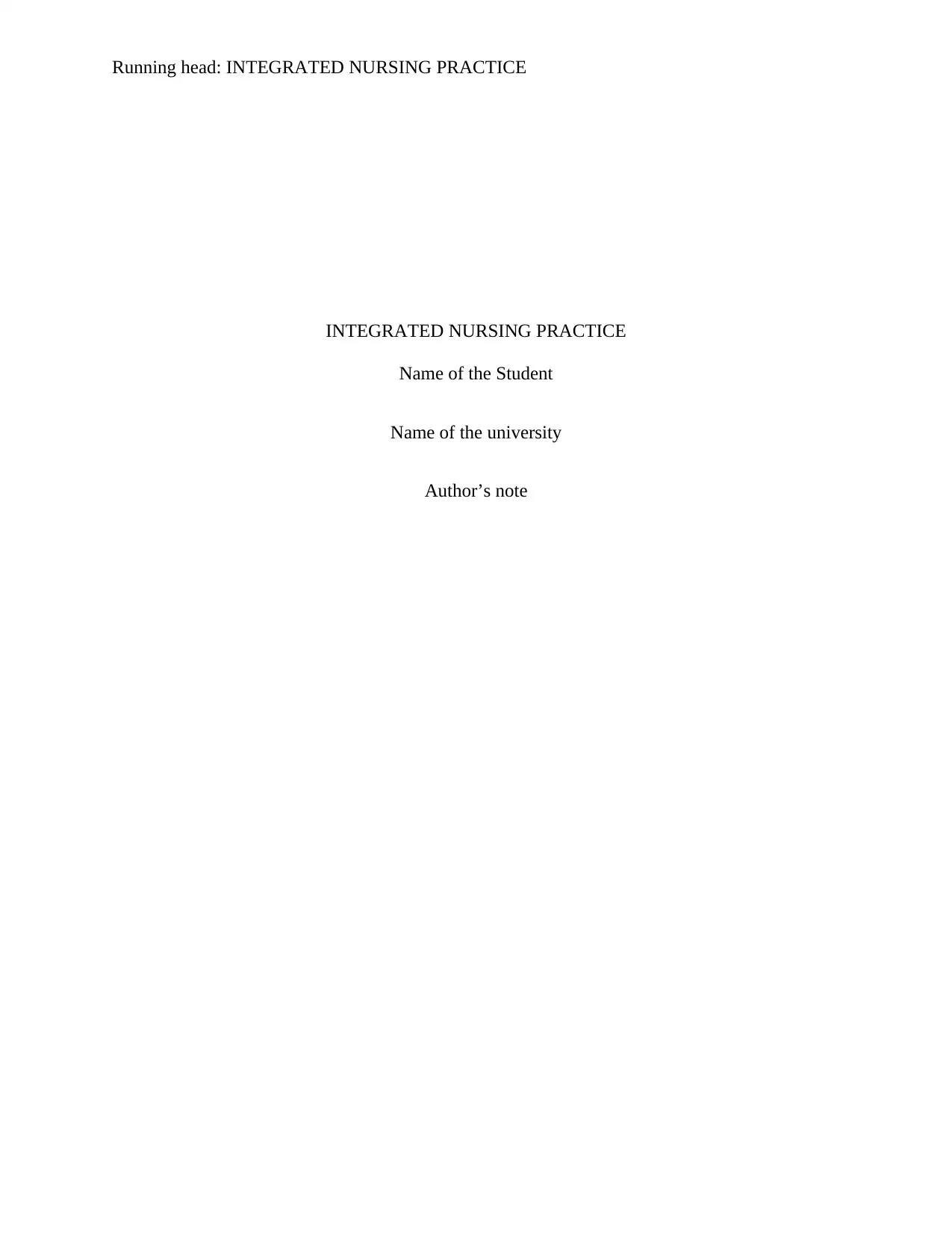
Running head: INTEGRATED NURSING PRACTICE
INTEGRATED NURSING PRACTICE
Name of the Student
Name of the university
Author’s note
INTEGRATED NURSING PRACTICE
Name of the Student
Name of the university
Author’s note
Paraphrase This Document
Need a fresh take? Get an instant paraphrase of this document with our AI Paraphraser
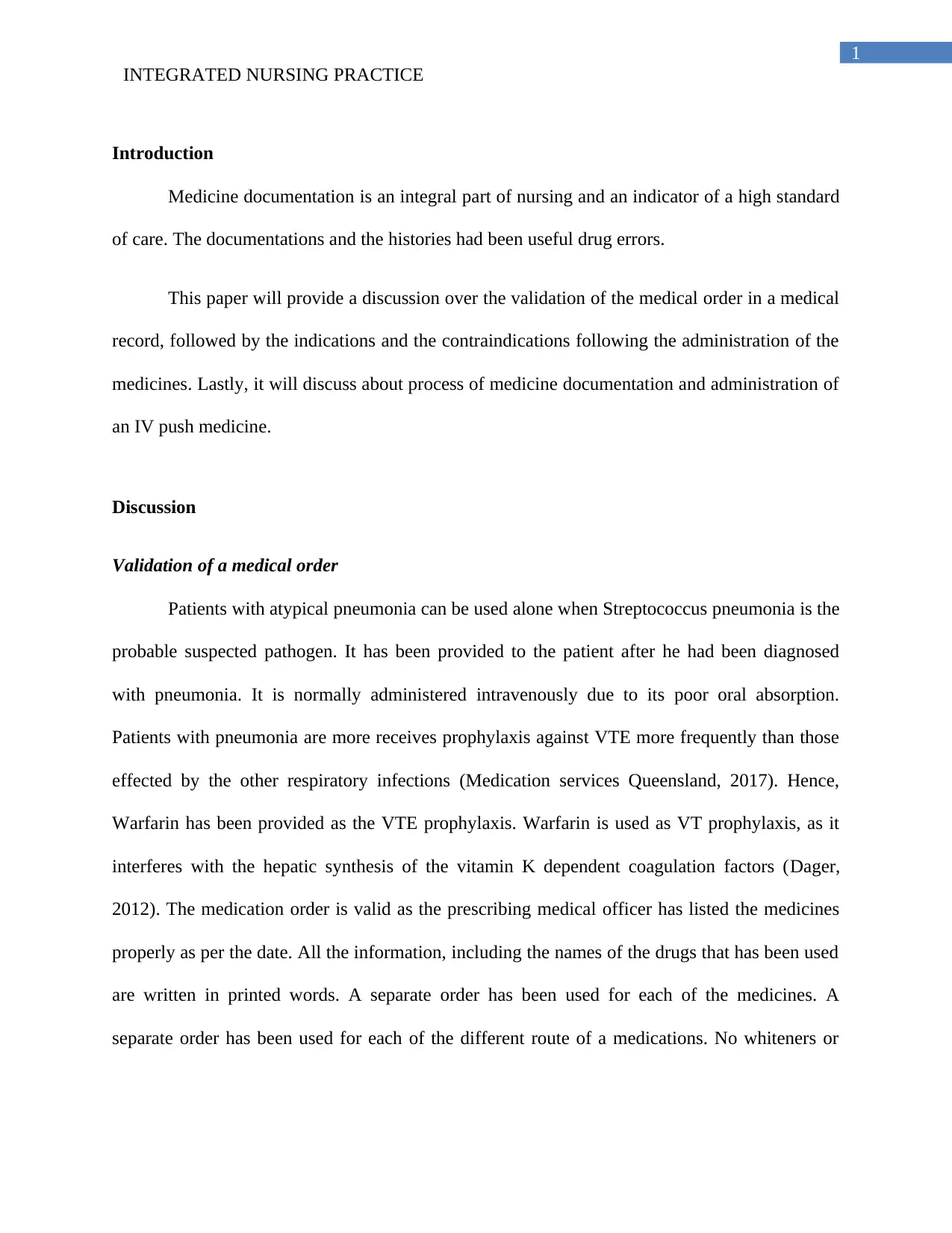
1
INTEGRATED NURSING PRACTICE
Introduction
Medicine documentation is an integral part of nursing and an indicator of a high standard
of care. The documentations and the histories had been useful drug errors.
This paper will provide a discussion over the validation of the medical order in a medical
record, followed by the indications and the contraindications following the administration of the
medicines. Lastly, it will discuss about process of medicine documentation and administration of
an IV push medicine.
Discussion
Validation of a medical order
Patients with atypical pneumonia can be used alone when Streptococcus pneumonia is the
probable suspected pathogen. It has been provided to the patient after he had been diagnosed
with pneumonia. It is normally administered intravenously due to its poor oral absorption.
Patients with pneumonia are more receives prophylaxis against VTE more frequently than those
effected by the other respiratory infections (Medication services Queensland, 2017). Hence,
Warfarin has been provided as the VTE prophylaxis. Warfarin is used as VT prophylaxis, as it
interferes with the hepatic synthesis of the vitamin K dependent coagulation factors (Dager,
2012). The medication order is valid as the prescribing medical officer has listed the medicines
properly as per the date. All the information, including the names of the drugs that has been used
are written in printed words. A separate order has been used for each of the medicines. A
separate order has been used for each of the different route of a medications. No whiteners or
INTEGRATED NURSING PRACTICE
Introduction
Medicine documentation is an integral part of nursing and an indicator of a high standard
of care. The documentations and the histories had been useful drug errors.
This paper will provide a discussion over the validation of the medical order in a medical
record, followed by the indications and the contraindications following the administration of the
medicines. Lastly, it will discuss about process of medicine documentation and administration of
an IV push medicine.
Discussion
Validation of a medical order
Patients with atypical pneumonia can be used alone when Streptococcus pneumonia is the
probable suspected pathogen. It has been provided to the patient after he had been diagnosed
with pneumonia. It is normally administered intravenously due to its poor oral absorption.
Patients with pneumonia are more receives prophylaxis against VTE more frequently than those
effected by the other respiratory infections (Medication services Queensland, 2017). Hence,
Warfarin has been provided as the VTE prophylaxis. Warfarin is used as VT prophylaxis, as it
interferes with the hepatic synthesis of the vitamin K dependent coagulation factors (Dager,
2012). The medication order is valid as the prescribing medical officer has listed the medicines
properly as per the date. All the information, including the names of the drugs that has been used
are written in printed words. A separate order has been used for each of the medicines. A
separate order has been used for each of the different route of a medications. No whiteners or
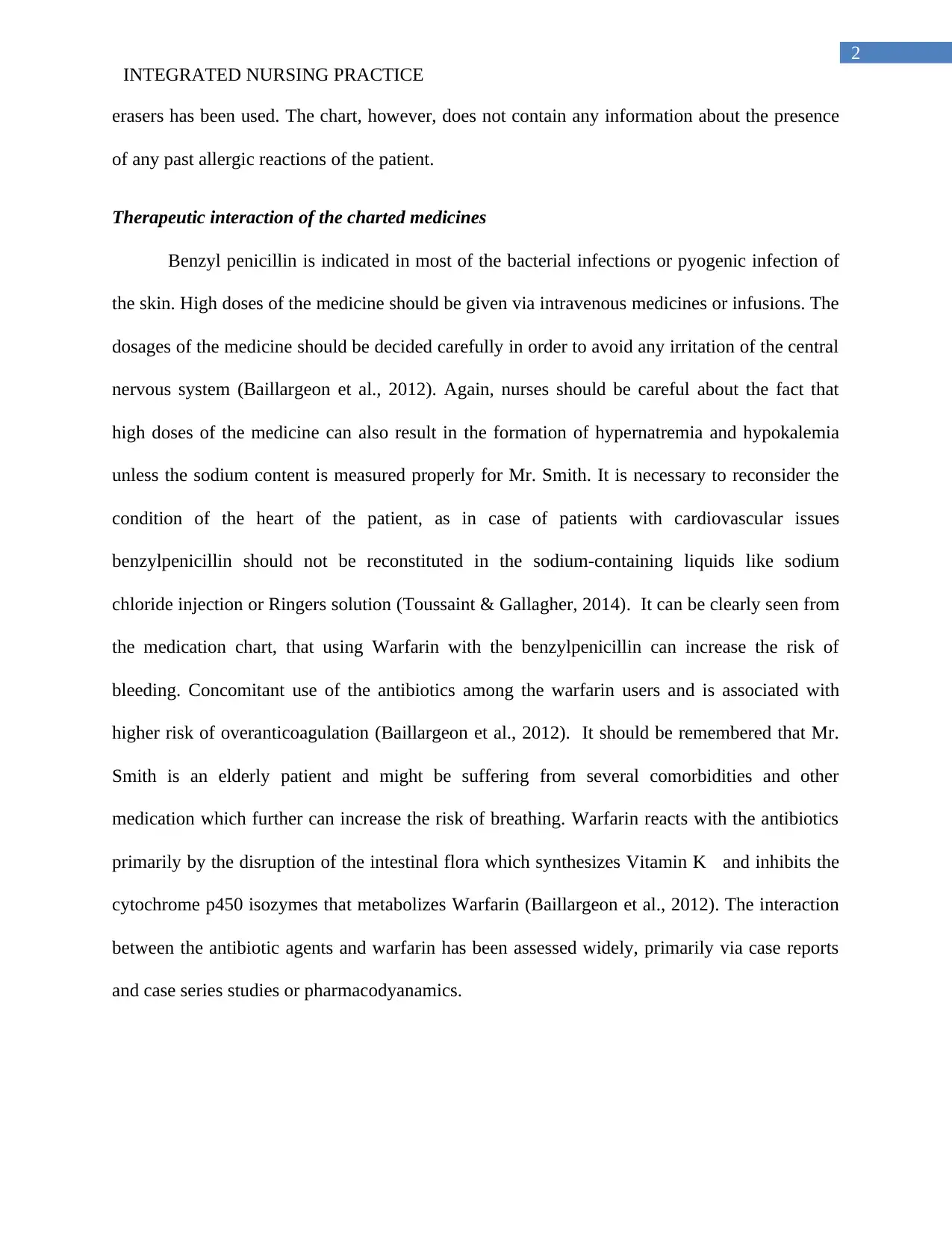
2
INTEGRATED NURSING PRACTICE
erasers has been used. The chart, however, does not contain any information about the presence
of any past allergic reactions of the patient.
Therapeutic interaction of the charted medicines
Benzyl penicillin is indicated in most of the bacterial infections or pyogenic infection of
the skin. High doses of the medicine should be given via intravenous medicines or infusions. The
dosages of the medicine should be decided carefully in order to avoid any irritation of the central
nervous system (Baillargeon et al., 2012). Again, nurses should be careful about the fact that
high doses of the medicine can also result in the formation of hypernatremia and hypokalemia
unless the sodium content is measured properly for Mr. Smith. It is necessary to reconsider the
condition of the heart of the patient, as in case of patients with cardiovascular issues
benzylpenicillin should not be reconstituted in the sodium-containing liquids like sodium
chloride injection or Ringers solution (Toussaint & Gallagher, 2014). It can be clearly seen from
the medication chart, that using Warfarin with the benzylpenicillin can increase the risk of
bleeding. Concomitant use of the antibiotics among the warfarin users and is associated with
higher risk of overanticoagulation (Baillargeon et al., 2012). It should be remembered that Mr.
Smith is an elderly patient and might be suffering from several comorbidities and other
medication which further can increase the risk of breathing. Warfarin reacts with the antibiotics
primarily by the disruption of the intestinal flora which synthesizes Vitamin K and inhibits the
cytochrome p450 isozymes that metabolizes Warfarin (Baillargeon et al., 2012). The interaction
between the antibiotic agents and warfarin has been assessed widely, primarily via case reports
and case series studies or pharmacodyanamics.
INTEGRATED NURSING PRACTICE
erasers has been used. The chart, however, does not contain any information about the presence
of any past allergic reactions of the patient.
Therapeutic interaction of the charted medicines
Benzyl penicillin is indicated in most of the bacterial infections or pyogenic infection of
the skin. High doses of the medicine should be given via intravenous medicines or infusions. The
dosages of the medicine should be decided carefully in order to avoid any irritation of the central
nervous system (Baillargeon et al., 2012). Again, nurses should be careful about the fact that
high doses of the medicine can also result in the formation of hypernatremia and hypokalemia
unless the sodium content is measured properly for Mr. Smith. It is necessary to reconsider the
condition of the heart of the patient, as in case of patients with cardiovascular issues
benzylpenicillin should not be reconstituted in the sodium-containing liquids like sodium
chloride injection or Ringers solution (Toussaint & Gallagher, 2014). It can be clearly seen from
the medication chart, that using Warfarin with the benzylpenicillin can increase the risk of
bleeding. Concomitant use of the antibiotics among the warfarin users and is associated with
higher risk of overanticoagulation (Baillargeon et al., 2012). It should be remembered that Mr.
Smith is an elderly patient and might be suffering from several comorbidities and other
medication which further can increase the risk of breathing. Warfarin reacts with the antibiotics
primarily by the disruption of the intestinal flora which synthesizes Vitamin K and inhibits the
cytochrome p450 isozymes that metabolizes Warfarin (Baillargeon et al., 2012). The interaction
between the antibiotic agents and warfarin has been assessed widely, primarily via case reports
and case series studies or pharmacodyanamics.
⊘ This is a preview!⊘
Do you want full access?
Subscribe today to unlock all pages.

Trusted by 1+ million students worldwide
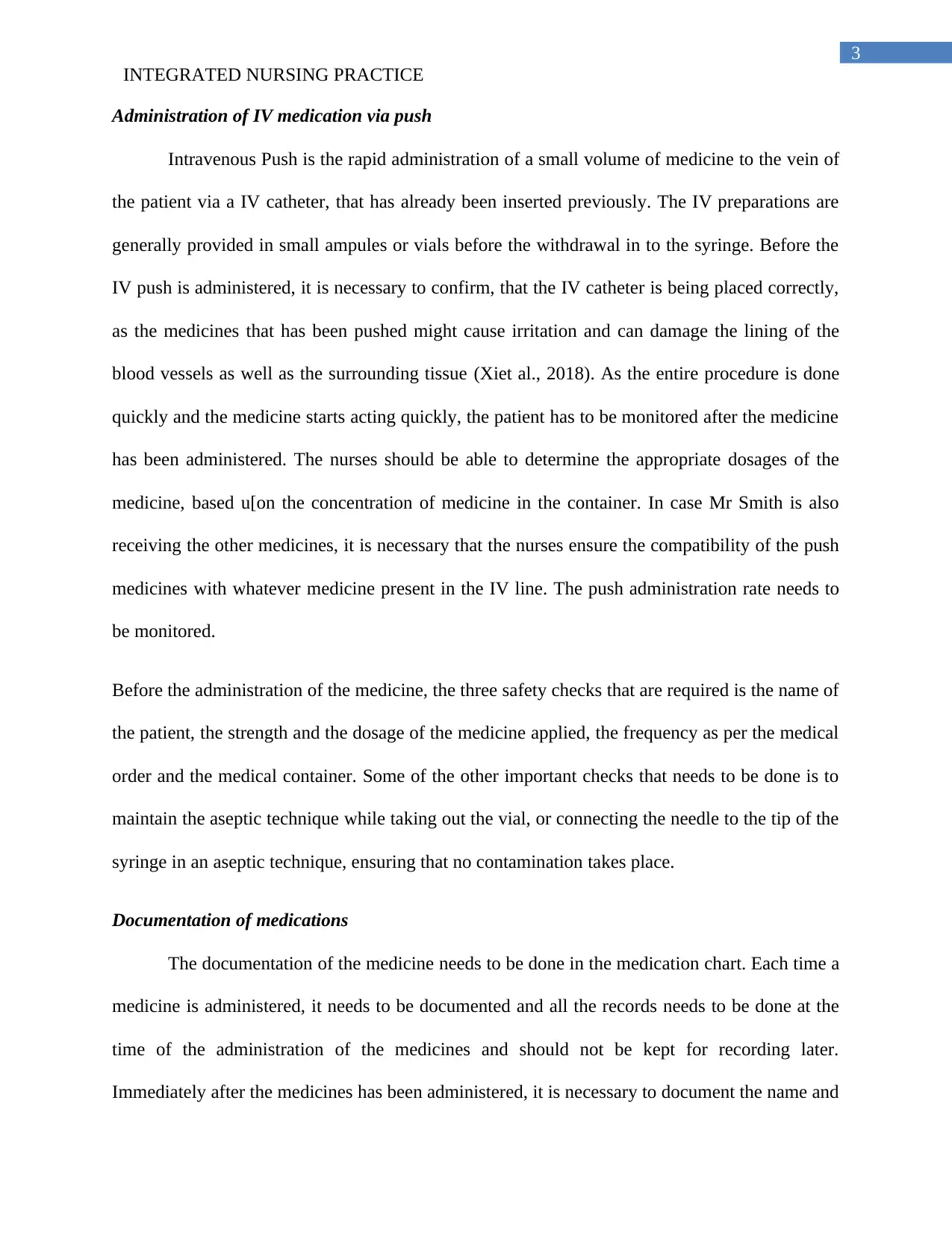
3
INTEGRATED NURSING PRACTICE
Administration of IV medication via push
Intravenous Push is the rapid administration of a small volume of medicine to the vein of
the patient via a IV catheter, that has already been inserted previously. The IV preparations are
generally provided in small ampules or vials before the withdrawal in to the syringe. Before the
IV push is administered, it is necessary to confirm, that the IV catheter is being placed correctly,
as the medicines that has been pushed might cause irritation and can damage the lining of the
blood vessels as well as the surrounding tissue (Xiet al., 2018). As the entire procedure is done
quickly and the medicine starts acting quickly, the patient has to be monitored after the medicine
has been administered. The nurses should be able to determine the appropriate dosages of the
medicine, based u[on the concentration of medicine in the container. In case Mr Smith is also
receiving the other medicines, it is necessary that the nurses ensure the compatibility of the push
medicines with whatever medicine present in the IV line. The push administration rate needs to
be monitored.
Before the administration of the medicine, the three safety checks that are required is the name of
the patient, the strength and the dosage of the medicine applied, the frequency as per the medical
order and the medical container. Some of the other important checks that needs to be done is to
maintain the aseptic technique while taking out the vial, or connecting the needle to the tip of the
syringe in an aseptic technique, ensuring that no contamination takes place.
Documentation of medications
The documentation of the medicine needs to be done in the medication chart. Each time a
medicine is administered, it needs to be documented and all the records needs to be done at the
time of the administration of the medicines and should not be kept for recording later.
Immediately after the medicines has been administered, it is necessary to document the name and
INTEGRATED NURSING PRACTICE
Administration of IV medication via push
Intravenous Push is the rapid administration of a small volume of medicine to the vein of
the patient via a IV catheter, that has already been inserted previously. The IV preparations are
generally provided in small ampules or vials before the withdrawal in to the syringe. Before the
IV push is administered, it is necessary to confirm, that the IV catheter is being placed correctly,
as the medicines that has been pushed might cause irritation and can damage the lining of the
blood vessels as well as the surrounding tissue (Xiet al., 2018). As the entire procedure is done
quickly and the medicine starts acting quickly, the patient has to be monitored after the medicine
has been administered. The nurses should be able to determine the appropriate dosages of the
medicine, based u[on the concentration of medicine in the container. In case Mr Smith is also
receiving the other medicines, it is necessary that the nurses ensure the compatibility of the push
medicines with whatever medicine present in the IV line. The push administration rate needs to
be monitored.
Before the administration of the medicine, the three safety checks that are required is the name of
the patient, the strength and the dosage of the medicine applied, the frequency as per the medical
order and the medical container. Some of the other important checks that needs to be done is to
maintain the aseptic technique while taking out the vial, or connecting the needle to the tip of the
syringe in an aseptic technique, ensuring that no contamination takes place.
Documentation of medications
The documentation of the medicine needs to be done in the medication chart. Each time a
medicine is administered, it needs to be documented and all the records needs to be done at the
time of the administration of the medicines and should not be kept for recording later.
Immediately after the medicines has been administered, it is necessary to document the name and
Paraphrase This Document
Need a fresh take? Get an instant paraphrase of this document with our AI Paraphraser
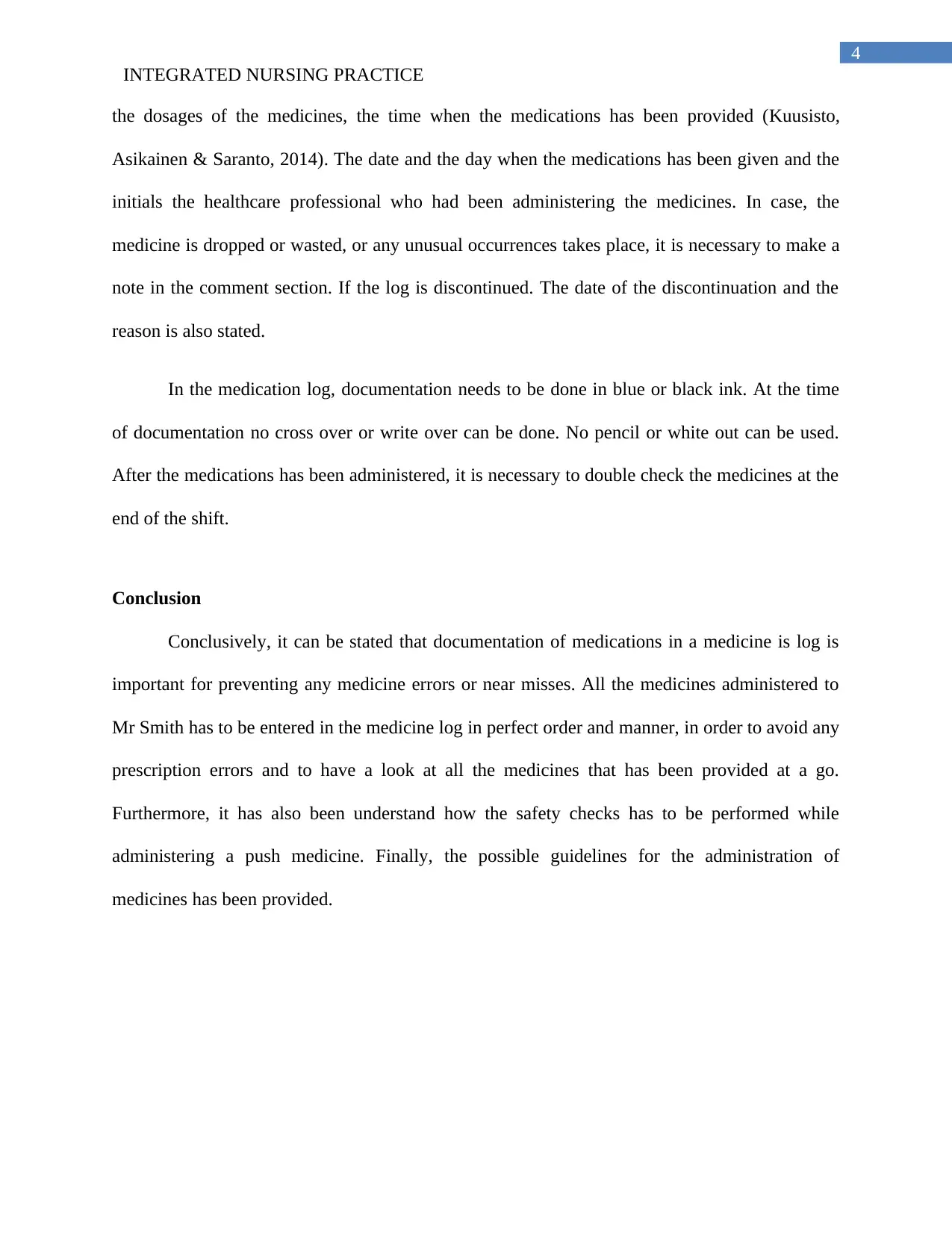
4
INTEGRATED NURSING PRACTICE
the dosages of the medicines, the time when the medications has been provided (Kuusisto,
Asikainen & Saranto, 2014). The date and the day when the medications has been given and the
initials the healthcare professional who had been administering the medicines. In case, the
medicine is dropped or wasted, or any unusual occurrences takes place, it is necessary to make a
note in the comment section. If the log is discontinued. The date of the discontinuation and the
reason is also stated.
In the medication log, documentation needs to be done in blue or black ink. At the time
of documentation no cross over or write over can be done. No pencil or white out can be used.
After the medications has been administered, it is necessary to double check the medicines at the
end of the shift.
Conclusion
Conclusively, it can be stated that documentation of medications in a medicine is log is
important for preventing any medicine errors or near misses. All the medicines administered to
Mr Smith has to be entered in the medicine log in perfect order and manner, in order to avoid any
prescription errors and to have a look at all the medicines that has been provided at a go.
Furthermore, it has also been understand how the safety checks has to be performed while
administering a push medicine. Finally, the possible guidelines for the administration of
medicines has been provided.
INTEGRATED NURSING PRACTICE
the dosages of the medicines, the time when the medications has been provided (Kuusisto,
Asikainen & Saranto, 2014). The date and the day when the medications has been given and the
initials the healthcare professional who had been administering the medicines. In case, the
medicine is dropped or wasted, or any unusual occurrences takes place, it is necessary to make a
note in the comment section. If the log is discontinued. The date of the discontinuation and the
reason is also stated.
In the medication log, documentation needs to be done in blue or black ink. At the time
of documentation no cross over or write over can be done. No pencil or white out can be used.
After the medications has been administered, it is necessary to double check the medicines at the
end of the shift.
Conclusion
Conclusively, it can be stated that documentation of medications in a medicine is log is
important for preventing any medicine errors or near misses. All the medicines administered to
Mr Smith has to be entered in the medicine log in perfect order and manner, in order to avoid any
prescription errors and to have a look at all the medicines that has been provided at a go.
Furthermore, it has also been understand how the safety checks has to be performed while
administering a push medicine. Finally, the possible guidelines for the administration of
medicines has been provided.
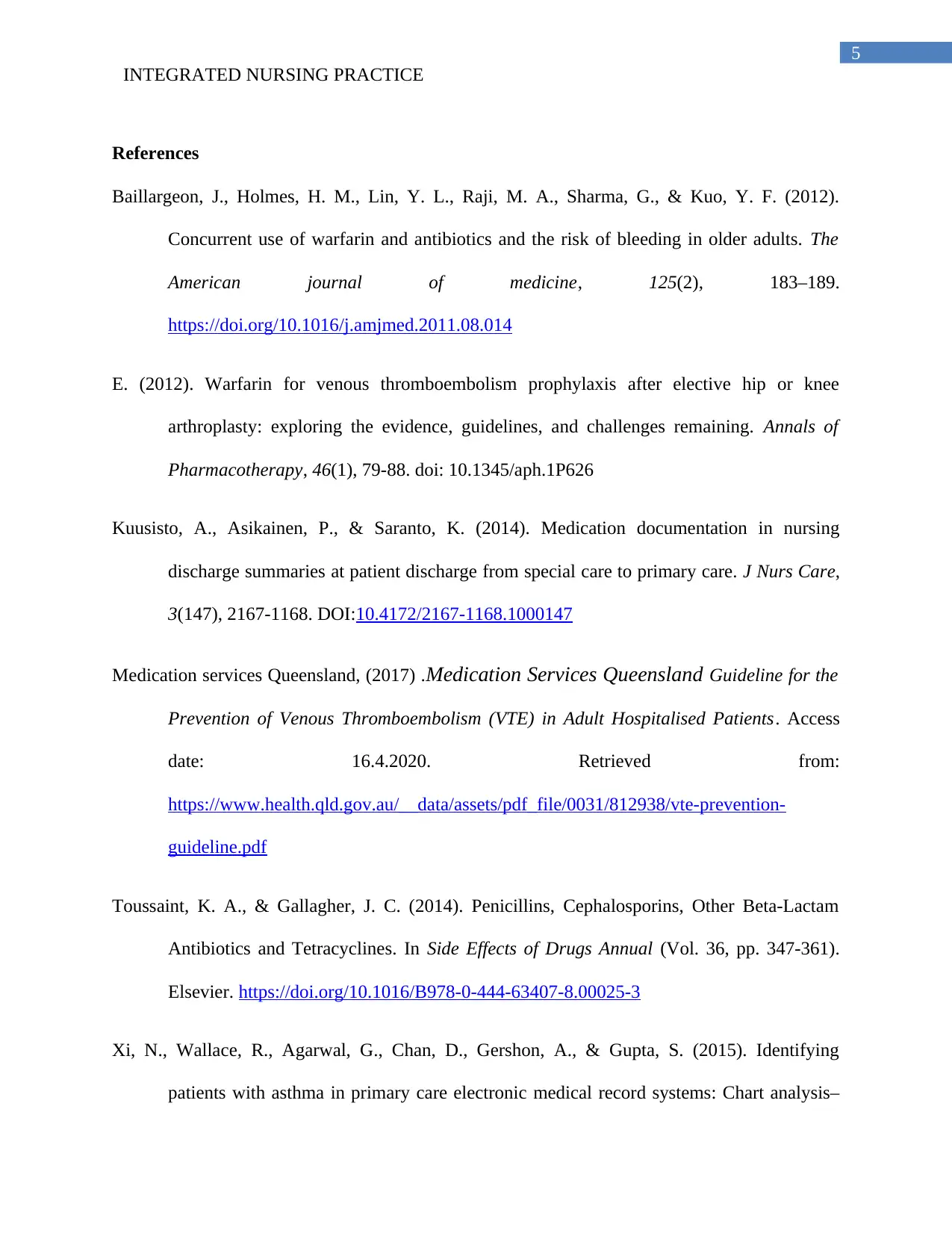
5
INTEGRATED NURSING PRACTICE
References
Baillargeon, J., Holmes, H. M., Lin, Y. L., Raji, M. A., Sharma, G., & Kuo, Y. F. (2012).
Concurrent use of warfarin and antibiotics and the risk of bleeding in older adults. The
American journal of medicine, 125(2), 183–189.
https://doi.org/10.1016/j.amjmed.2011.08.014
E. (2012). Warfarin for venous thromboembolism prophylaxis after elective hip or knee
arthroplasty: exploring the evidence, guidelines, and challenges remaining. Annals of
Pharmacotherapy, 46(1), 79-88. doi: 10.1345/aph.1P626
Kuusisto, A., Asikainen, P., & Saranto, K. (2014). Medication documentation in nursing
discharge summaries at patient discharge from special care to primary care. J Nurs Care,
3(147), 2167-1168. DOI:10.4172/2167-1168.1000147
Medication services Queensland, (2017) .Medication Services Queensland Guideline for the
Prevention of Venous Thromboembolism (VTE) in Adult Hospitalised Patients. Access
date: 16.4.2020. Retrieved from:
https://www.health.qld.gov.au/__data/assets/pdf_file/0031/812938/vte-prevention-
guideline.pdf
Toussaint, K. A., & Gallagher, J. C. (2014). Penicillins, Cephalosporins, Other Beta-Lactam
Antibiotics and Tetracyclines. In Side Effects of Drugs Annual (Vol. 36, pp. 347-361).
Elsevier. https://doi.org/10.1016/B978-0-444-63407-8.00025-3
Xi, N., Wallace, R., Agarwal, G., Chan, D., Gershon, A., & Gupta, S. (2015). Identifying
patients with asthma in primary care electronic medical record systems: Chart analysis–
INTEGRATED NURSING PRACTICE
References
Baillargeon, J., Holmes, H. M., Lin, Y. L., Raji, M. A., Sharma, G., & Kuo, Y. F. (2012).
Concurrent use of warfarin and antibiotics and the risk of bleeding in older adults. The
American journal of medicine, 125(2), 183–189.
https://doi.org/10.1016/j.amjmed.2011.08.014
E. (2012). Warfarin for venous thromboembolism prophylaxis after elective hip or knee
arthroplasty: exploring the evidence, guidelines, and challenges remaining. Annals of
Pharmacotherapy, 46(1), 79-88. doi: 10.1345/aph.1P626
Kuusisto, A., Asikainen, P., & Saranto, K. (2014). Medication documentation in nursing
discharge summaries at patient discharge from special care to primary care. J Nurs Care,
3(147), 2167-1168. DOI:10.4172/2167-1168.1000147
Medication services Queensland, (2017) .Medication Services Queensland Guideline for the
Prevention of Venous Thromboembolism (VTE) in Adult Hospitalised Patients. Access
date: 16.4.2020. Retrieved from:
https://www.health.qld.gov.au/__data/assets/pdf_file/0031/812938/vte-prevention-
guideline.pdf
Toussaint, K. A., & Gallagher, J. C. (2014). Penicillins, Cephalosporins, Other Beta-Lactam
Antibiotics and Tetracyclines. In Side Effects of Drugs Annual (Vol. 36, pp. 347-361).
Elsevier. https://doi.org/10.1016/B978-0-444-63407-8.00025-3
Xi, N., Wallace, R., Agarwal, G., Chan, D., Gershon, A., & Gupta, S. (2015). Identifying
patients with asthma in primary care electronic medical record systems: Chart analysis–
⊘ This is a preview!⊘
Do you want full access?
Subscribe today to unlock all pages.

Trusted by 1+ million students worldwide
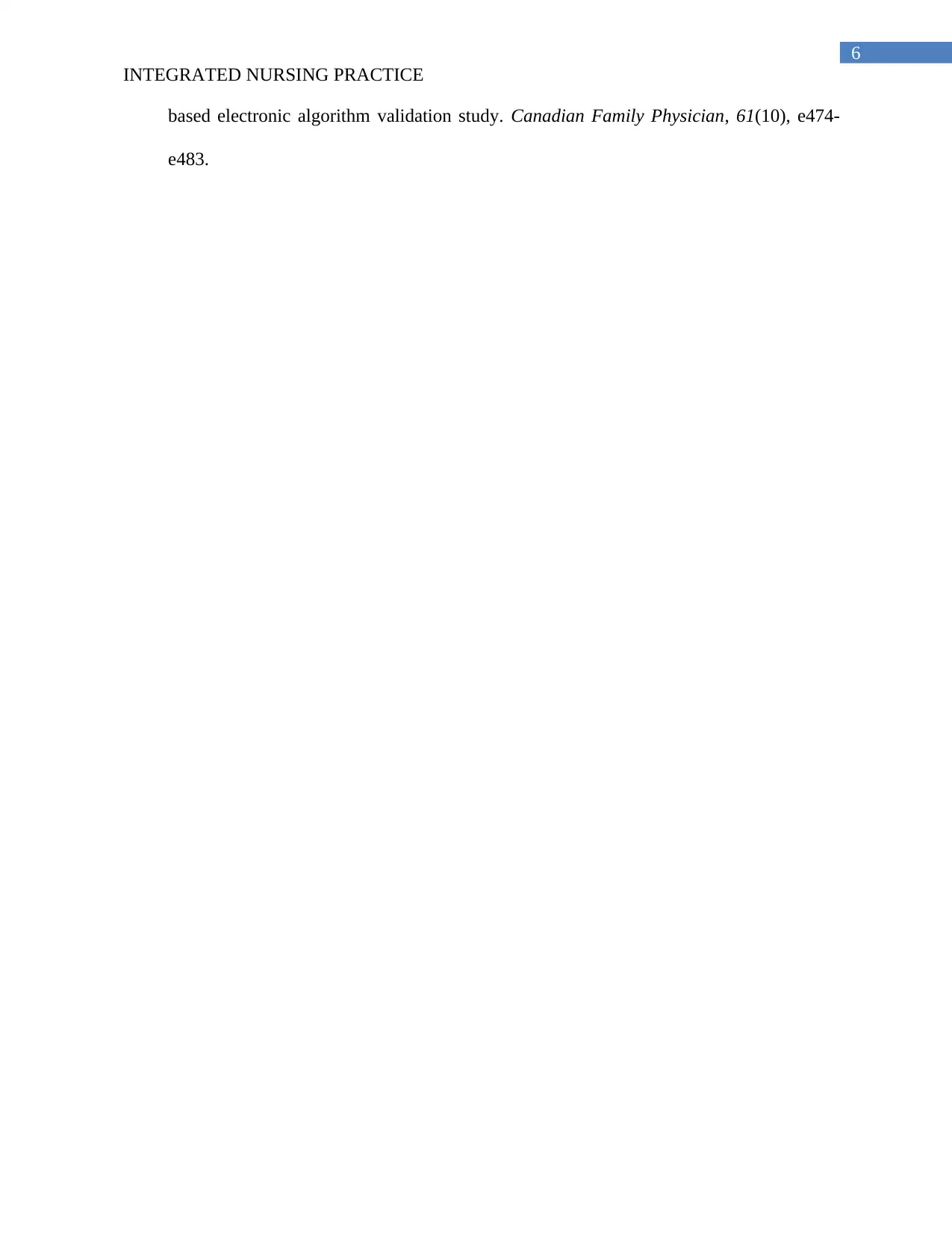
6
INTEGRATED NURSING PRACTICE
based electronic algorithm validation study. Canadian Family Physician, 61(10), e474-
e483.
INTEGRATED NURSING PRACTICE
based electronic algorithm validation study. Canadian Family Physician, 61(10), e474-
e483.
1 out of 7
Related Documents
Your All-in-One AI-Powered Toolkit for Academic Success.
+13062052269
info@desklib.com
Available 24*7 on WhatsApp / Email
![[object Object]](/_next/static/media/star-bottom.7253800d.svg)
Unlock your academic potential
Copyright © 2020–2025 A2Z Services. All Rights Reserved. Developed and managed by ZUCOL.





